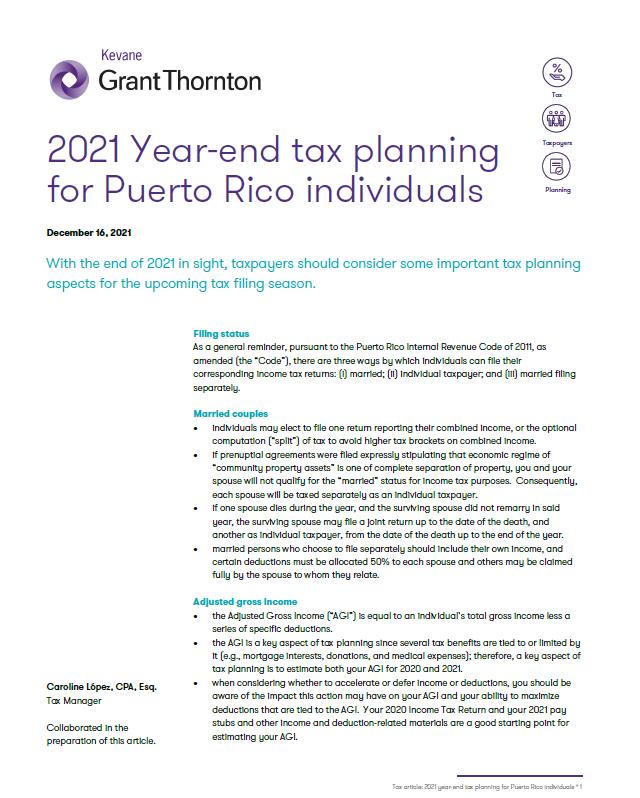-
Financial statements audits
Financial statement audits
-
Compliance audits
Compliance audits
-
Compilations and reviews
Compilations and audit
-
Agreed-upon procedures
Agreed-upon procedures
-
Corporate and business tax
Our trusted teams can prepare corporate tax files and ruling requests, support you with deferrals, accounting procedures and legitimate tax benefits.
-
International tax
Our teams have in-depth knowledge of the relationship between domestic and international tax laws.
-
Tax compliance
Business Tax
-
Individual taxes
Individual taxes
-
Estate and succession planning
Estate and succession planning
-
Global mobility services
Through our global organisation of member firms, we support both companies and individuals, providing insightful solutions to minimise the tax burden for both parties.
-
Sales and use tax and indirect taxes
SUT/ VAT & indirect taxes
-
Tax incentives program
Tax incentives program
-
Transfer Pricing Study
The laws surrounding transfer pricing are becoming ever more complex, as tax affairs of multinational companies are facing scrutiny from media, regulators and the public
-
Business consulting
Our business consulting services can help you improve your operational performance and productivity, adding value throughout your growth life cycle.
-
Forensic and investigative services
At Grant Thornton, we have a wealth of knowledge in forensic services and can support you with issues such as dispute resolution, fraud and insurance claims.
-
Fraud and investigations
The commercial landscape is changing fast. An ever more regulated environment means organizations today must adopt stringent governance and compliance processes. As business has become global, organizations need to adapt to deal with multi-jurisdictional investigations, litigation, and dispute resolution, address the threat of cyber-attack and at the same time protect the organization’s value.
-
Dispute resolutions
Our independent experts are experienced in advising on civil and criminal matters involving contract breaches, partnership disputes, auditor negligence, shareholder disputes and company valuations, disputes for corporates, the public sector and individuals. We act in all forms of dispute resolution, including litigation, arbitration, and mediation.
-
Business risk services
We can help you identify, understand and manage potential risks to safeguard your business and comply with regulatory requirements.
-
Internal audit
We work with our clients to assess their corporate level risk, identify areas of greatest risk and develop appropriate work plans and audit programs to mitigate these risks.
-
Service organization reports
As a service organization, you know how important it is to produce a report for your customers and their auditors that instills confidence and enhances their trust in your services. Grant Thornton Advisory professionals can help you determine which report(s) will satisfy your customers’ needs and provide relevant information to your customers and customers’ auditors that will be a business benefit to you.
-
Transaction advisory services
Transactions are significant events in the life of a business – a successful deal that can have a lasting impact on the future shape of the organizations involved. Because the stakes are high for both buyers and sellers, experience, determination and pragmatism are required to bring deals safely through to conclusion.
-
Mergers and acquisitions
Globalization and company growth ambitions are driving an increase in M&A activity worldwide as businesses look to establish a footprint in countries beyond their own. Even within their own regions, many businesses feel the pressure to acquire in order to establish a strategic presence in new markets, such as those being created by rapid technological innovation.
-
Valuations
We can support you throughout the transaction process – helping achieve the best possible outcome at the point of the transaction and in the longer term.
-
Recovery and reorganization
We provide a wide range of services to recovery and reorganisation professionals, companies and their stakeholders.
Filing status
As a general reminder, pursuant to the Puerto Rico Internal Revenue Code of 2011, as amended (the “Code”), there are three ways by which individuals can file their corresponding income tax returns: (i) married; (ii) individual taxpayer; and (iii) married filing separately.
Married couples
- individuals may elect to file one return reporting their combined income, or the optional computation (“split”) of tax to avoid higher tax brackets on combined income.
- if prenuptial agreements were filed expressly stipulating that economic regime of “community property assets” is one of complete separation of property, you and your spouse will not qualify for the “married” status for income tax purposes. Consequently, each spouse will be taxed separately as an individual taxpayer.
- if one spouse dies during the year, and the surviving spouse did not remarry in said year, the surviving spouse may file a joint return up to the date of the death, and another as individual taxpayer, from the date of the death up to the end of the year.
- married persons who choose to file separately should include their own income, and certain deductions must be allocated 50% to each spouse and others may be claimed fully by the spouse to whom they relate.
Adjusted gross income
- the Adjusted Gross Income (“AGI”) is equal to an individual’s total gross income less a series of specific deductions.
- the AGI is a key aspect of tax planning since several tax benefits are tied to or limited by it (e.g., mortgage interests, donations, and medical expenses); therefore, a key aspect of tax planning is to estimate both your AGI for 2020 and 2021.
- when considering whether to accelerate or defer income or deductions, you should be aware of the impact this action may have on your AGI and your ability to maximize deductions that are tied to the AGI. Your 2020 Income Tax Return and your 2021 pay stubs and other income and deduction-related materials are a good starting point for estimating your AGI.
Regular tax
- for taxable year 2021, the tax determined will be 95% of the total regular tax and gradual adjustment. Also, for taxable years beginning after December 31, 2019, and for individuals with a gross revenue less than 100,001, the tax determined will be 92% of the regular and gradual adjustment, instead of 95%.
- tax rates for ordinary income are:
| Net taxable income | Tax rate |
| up to $9,000 | 0% |
| more than $9,000 but not more than $25,000 | 7% |
| more than $25,000 but not more than $41,500 | 14% |
| more than $41,500 but not more than $61,500 | 25% |
| more than $61,500 | 33% |
Alternate basic tax
- an alternate basic tax in lieu of any other tax will be paid for each taxable year upon the Alternate Basic Tax (“ABT”) income of every individual as follows:
| ABT income | Tax rate |
| over from $25,000 but not more than $50,000 | 1% |
| more than $50,000 but not more than $75,000 | 3% |
| more than $75,000 but not more than $150,000 | 5% |
| more than $150,000 but not more than $250,000 | 10% |
| over $250,000 | 24% |
Optional computation for self-employed individuals
- an optional computation tax is available for self-employed individuals who derive their income substantially from services that are subject to withholding at source.“Substantially” means 80% or more of the services performed.
- tax is computed on gross revenue without the benefit of operating expenses or personal deductions.
- tax must be covered by withholding or estimated tax payments.
- the remain of gross income not attributed to the performing of services (20% or less) shall be taxed at ordinary tax rate.
- tax will be paid for each taxable year upon the optional computation income of every individual as follows:
| Optional tax income | Tax rate |
| up to $100,000 | 6% |
| more than $100,000 but not more than $200,000 | 10% |
| more than $200,000 but not more than $300,000 | 13% |
| more than $300,000 but not more than $400,000 | 15% |
| more than $400,000 but not more than $500,000 | 17% |
| more than $500,000 | 20% |
Retirement savings
- the annual deductible contribution for an IRA for 2021 is $5,000 or the aggregate AGI from salaries and the earnings attributable to professions, whichever is smaller. In case of married taxpayers filing a joint return, the contribution cannot exceed $10,000 ($5,000 for each spouse). One spouse may establish an IRA in the name of the other spouse, whether if the other spouse generates income or not.
- participation in an employer pension plan does not disqualify an individual to make deductible contributions to an IRA.
- if you did not elect the maximum plan contribution for 2021, you can increase your amount for the remainder of 2021 to lower your AGI in order to take advantage of some of the deductions described above and/or lower the tax rate on the year. In addition, maximizing your contribution is generally a good tax-saving move.
Deferring income to 2022 + accelerating deductions into 2021
If you expect your AGI to be higher in 2022 than in 2021, or if you anticipate being in the same or a higher bracket in 2021, you may benefit by deferring income into 2022 and increase deductions in 2021. Deferring income or accelerating deductions may be advantageous if it does not bump your income to the next tax rate bracket in 2022.
In case the deferring income or accelerating deductions is beneficial, some options include:
Charitable contributions
Consider making a large charitable contribution in 2021, rather than in 2022.
Capital gains
If you are considering selling assets that will generate a gain, postpone the sale until 2022 or contemplate investing in an Opportunity Zone Fund. Also, for the sale of certain property you may consider an instalment sale method.
Accelerating income into 2021 + deferring deductions to 2022
If you anticipate being in a higher tax bracket in 2022 or perhaps you need additional income for 2021 to take advantage of an offsetting deduction or credit this tax year. Note, however, that accelerating income into 2021 will be disadvantageous if you expect to be in the same or lower tax bracket for 2022.
If accelerating income/deferring deductions will be beneficial, some options include:
Accelerate collection of accounts receivable
If you are self-employed and report income and expenses on a cash basis, issue bills and attempt collection before the end of 2021. Also, provide an incentive that motivates your clients to pay for January 2022 invoices in advance. A good example is to honor discounts.
Retirement plan distributions
If you are 60 years of age and participate in an employer retirement plan or have an IRA, consider making taxable withdrawals before year-end.
Personal and dependents exemptions
| Personal exemptions | Amount |
| Married | $7,000 |
| Individual taxpayer | $3,500 |
| Married filing separately | $3,500 |
| Exemption for each dependent | $2,500 |
| Veteran’s exemption | $1,500 |
Capital gains
- short term: capital gains on property held for one year or less are deemed short-term and will be taxed as ordinary income tax rates.
- long term: capital gains on property held for more than one year are deemed long-term and will be taxed at a preferential tax rate of 15%.
- capital gains invested in opportunity zones: certain eligible capital gains may be subject to temporary deferral of income tax by timely investing the eligible gain, or a portion thereof, in a qualified opportunity fund. If the investment is held in the qualified opportunity fund for at least 5 years, the basis of the original gain deferred is increased by 10%. An opportunity zone investment may be eligible for this 5-year incentive for timely investments made on or before December 31, 2021, because the statutory tax year to issue applicable payment of the tax on the original gain is December 31, 2026. Furthermore, if the investment is held for at least 10 years, any appreciation of the qualified opportunity fund investment is tax-free.
Capital losses
- capital losses may offset, in the case of a corporation up to 90% of capital gains for taxable years beginning after December 31, 2021. In the case of an individual taxpayer the offset is limited to the lesser of net income or $1,000, with a carryover period of 7 years.
Caroline López, CPA, Esq.
Tax Manager
Collaborated in the preparation of this article.
We are committed to keeping you up to date with all tax-related developments. Please contact our Tax Department should additional information be required regarding this or any other tax issue. We will be glad to assist you.



